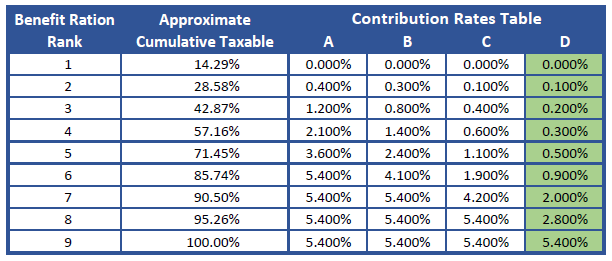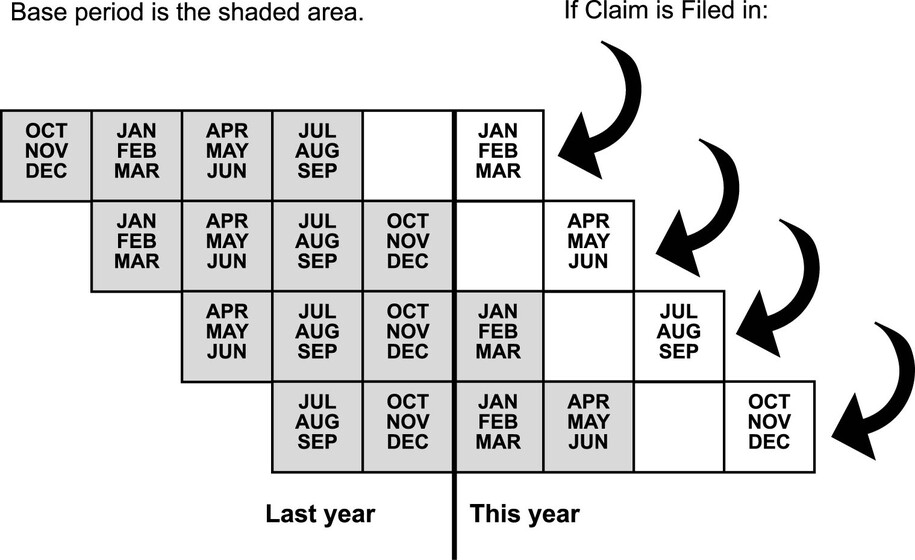Content Information
Employer’s Account
- The unemployment insurance (UI) tax payments are deposited into the UI Trust Fund.
- The employer's account is credited with the tax payment.
- The employer's account is also charged for all regular UI benefit payments and 50 percent of extended benefit payments to former employees who are qualified .
- The benefit charges to the employer’s account are used to determine your future UI tax rate.
North American Industry Classification System (NAICS)
- Each UI account is assigned a NAICS classification based upon the activities in which they are primarily engaged.
- NAICS is a comprehensive system covering the entire spectrum of economic activities, both producing and non-producing.
- NAICS uses a six-digit numerical coding system to identify particular industries and their placement in the classification system compared to all other North America industries.
- State Unemployment Tax (SUTA) uses this classification process to determine if an employer is considered a construction industry or non-construction industry.
- The myIowaUI account homepage lists your NAICS classification.
- Complete NAICS information can be found at www.census.gov/naics.
Tax Rate Tables
UI contributions may be collected from employers under four different tax rate tables. Each tax table has 9 ranks. Tax rates vary from 0.000% to 5.400%.
The tax tables were established to help maintain the solvency of the UI Trust Fund. As such, a formula in the law mandates movement to a table that collects more revenue when the balance in the UI Trust Fund is low, and movement to a table collecting less revenue when the balance is high.
The rate table in effect for any given year is applicable to all participating employers. The rate table in effect for all private employers for 2026 is Contribution Rate Table D, the lowest rate allowed by law.

New Employers
- New non-construction employers are assigned the rate from Rank 4 of the table in effect but not less than 1.000%, whichever is higher.
- For 2026, the rate is 1.000%.
- New construction employers are assigned the rate from Rank 9 of the table in effect.
- For 2026, the rate is 5.400%.
- Once you are an eligible employer, you will receive a computed UI Tax Rate.
Determining Each Employer’s Benefit Ratio
In addition to mandating the tax table in effect, Iowa’s UI law provides a formula for determining the tax rates of individual employers.
Two factors are calculated in the benefit ratio system. An employer’s five-year average annual benefit payment is divided by the employer’s five-year average annual taxable payroll. The result is benefits expressed as a percent of taxable payroll, or a benefit ratio. Each employer’s benefit ratio is then compared to every other employer’s benefit ratio in a ranking or array system. Those employers with the lowest benefit ratio receive the lowest tax rates.

Ranking Employers by Benefit Ratio
Your rank as an employer is determined by how your benefit ratio compares to the benefit ratios of other employers.
- Employers are listed by increasing benefit ratios, from lowest to highest.
Employers are grouped on the list into 9 ranks using the total taxable wages, excluding reimbursable employment wages, reported by the same employers for the four calendar quarters immediately before the computation date (July1).
- Ranks one through six contain 14.29% of the total taxable wages reported by the same employers.
- Ranks seven, eight and nine contain 4.76% of the total taxable wages reported by the same employers.
Note:
- All employers with the same benefit ratio are assigned the same rank.
- Employers with taxable wages that overlap ranks are assigned the lower of the two ranks.
- For 2026, the taxable wage base is $20,400.00.
Applying the Rate Table to the Rankings
- Notice of Tax Rate is sent in November of each year for the following tax year.
- Employers whose benefit ratios place them in Rank 1 are assigned the corresponding Rank 1 rate from the rate table.
- Therefore, employers in Rank 2 are assigned the corresponding Rank 2 rate, etc. until all employers have been assigned rates.
- Refer to the Notice of Tax Rate for a breakdown of the quarterly taxable wages and benefit charges applied to the account.
- For Federal 940 Certification purposes, the State Experience Rate indicated on the Notice of Tax Rate is the State Experience Rate as defined on the federal form 940.
Appealing Your Notice of Tax Rate
If you do not agree with your Notice of Tax Rate, an appeal may be filed An appeal must:
- Be in writing
- Be filed within 30 days of the rate notice date
- State that it is an appeal
- Include your Iowa Employer Account Number
Provide the grounds for appeal. Grounds include:
- An error in the rate
- A favorable claims decision issued since the rate computation date or that you expect to receive one on an appeal in progress.
Note: Grounds do not include fairness or financial hardship. We can not reduce rates that are correctly calculated.
- Be mailed to:
Iowa Workforce Development
Unemployment Insurance Tax Bureau
1000 East Grand Ave.
Des Moines IA 50319-0209
Taxable Wage Base
- The taxable wage base is the part of an employee’s wage upon which the employer must pay UI taxes.
- The taxable wage base in Iowa is the greater of these two formulas:
- Thirty-three and one-third of the statewide average weekly wage multiplied by 52.;
- Or, the taxable wage base for the Federal Unemployment Tax Act (FUTA).
- The employer pays UI taxes on each employee's wages up to the taxable wage base (you do not pay tax on wages exceeding the taxable wage base).
- The taxable wage base in 2025 is $39,500.00
- The taxable wage base in 2026 is $20,400.00
Charging Employer Accounts for Benefits Paid
Benefits paid on a UI claim are generally charged to the accounts of the claimant's base-period employers. The most recent base-period employer is charged first with benefits paid until the wage credits are exhausted. Once wage credits are exhausted from the most recent base-period employer, charges go the next most recent employer and so on.
The base-period is a four quarter (one year) time frame using the first four of the last five completed calendar quarters at the time an initial UI claim is filed. The diagram below identifies how to determine the base period. For additional information, please refer to the Unemployment Insurance Benefits Handbook.

Notification of Benefits Paid and Charged to Employer’s Account
Statement of Charges
Within 40 days after the close of each calendar quarter, IWD sends each contributory employer a Statement of Charges listing the UI benefits paid to former employees and charged to the employer’s UI tax account.
This statement is sent for informational purposes and is not a bill. In order to compare this statement to your annual Notice of Tax Rate, you should retain it for five years. You are given 30 days from the date the Statement of Charges was sent to file an appeal of any charges that are shown on the statement. Instructions for appealing are on the back of the statement.
Statement of Amount Due
If your account carries an outstanding balance, you will receive a monthly Statement of Amount Due. Interest will continue to accrue daily on contributions due until the amount is paid in full. Failure to pay may result in further collection action such as: Jeopardy Assessments, Liens, Distress Warrants, Garnishments, Injunctions and/or taking an offset from payment due to you from the State of Iowa or the Internal Revenue Service. If you are unable to make payment in full, contact UI Tax Collections to see if you qualify for a payment plan.
Notice of Reimbursable Benefit Charges
Within 30 days after the close of each calendar quarter, IWD sends each reimbursable employer a Notice of Reimbursable Benefit Charges listing the UI benefits paid to former employees and charged to the employer's UI tax account.
This notice is sent for collection purposes. Payment in full is due within 30 days of the date the notice is sent to avoid interest. If the amount due is not paid within 30 days, interest will accrue at the rate of 1 percent per month on the remaining balance until paid in full (1/30 of 1 percent per day).
You are given 15 days from the date the Notice of Reimbursable Benefit Charges was sent to file an appeal of any charges that are on the notice. Instructions for appealing are on the back of the notice.
Federal Unemployment Tax Act
- Most private employers covered by the Iowa UI Program are subject to the Federal Unemployment Tax Act (FUTA).
- You can receive a maximum credit equal to 5.4 percent against this tax if you are participating in a state UI program that meets federal requirements.
- The FUTA tax for 2025 is scheduled to be 6.0 percent on the first $7,000.00 of wages paid to employees.
- Due to the ongoing solvency of the UI Trust Fund, the 5.4 percent credit is applied to all accounts, making the tax rate 0.6 percent on the first $7,000.00 of wages paid to employees.
- The federal tax is allocated back to the states to pay costs for administering the law and provide funding for 50 percent of extended benefits (EB).
- Any remaining funds are put in a federal loan account for states to use on a loan basis in the event their state benefit funds become depleted.
- The State Experience Rate indicated on the Notice of UI Contribution Rate is the State Experience rate for federal form 940 certification purposes.